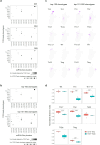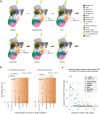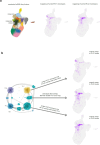Repertoire-based mapping and time-tracking of T helper cell subsets in scRNA-Seq
- PMID: 40255395
- PMCID: PMC12006041
- DOI: 10.3389/fimmu.2025.1536302
Repertoire-based mapping and time-tracking of T helper cell subsets in scRNA-Seq
Abstract
Introduction: The functional programs of CD4+ T helper (Th) cell clones play a central role in shaping immune responses to different challenges. While advances in single-cell RNA sequencing (scRNA-Seq) have significantly improved our understanding of the diversity of Th cells, the relationship between scRNA-Seq clusters and the traditionally characterized Th subsets remains ambiguous.
Methods: In this study, we introduce TCR-Track, a method leveraging immune repertoire data to map phenotypically sorted Th subsets onto scRNA-Seq profiles.
Results and discussion: This approach accurately positions the Th1, Th1-17, Th17, Th22, Th2a, Th2, T follicular helper (Tfh), and regulatory T-cell (Treg) subsets, outperforming mapping based on CITE-Seq. Remarkably, the mapping is tightly focused on specific scRNA-Seq clusters, despite 4-year interval between subset sorting and the effector CD4+ scRNA-Seq experiment. These findings highlight the intrinsic program stability of Th clones circulating in peripheral blood. Repertoire overlap analysis at the scRNA-Seq level confirms that the circulating Th1, Th2, Th2a, Th17, Th22, and Treg subsets are clonally independent. However, a significant clonal overlap between the Th1 and cytotoxic CD4+ T-cell clusters suggests that cytotoxic CD4+ T cells differentiate from Th1 clones. In addition, this study resolves a longstanding ambiguity: we demonstrate that, while CCR10+ Th cells align with a specific Th22 scRNA-Seq cluster, CCR10-CCR6+CXCR3-CCR4+ cells, typically classified as Th17, represent a mixture of bona fide Th17 cells and clonally unrelated CCR10low Th22 cells. The clear distinction between the Th17 and Th22 subsets should influence the development of vaccine- and T-cell-based therapies. Furthermore, we show that severe acute SARS-CoV-2 infection induces systemic type 1 interferon (IFN) activation of naive Th cells. An increased proportion of effector IFN-induced Th cells is associated with a moderate course of the disease but remains low in critical COVID-19 cases. Using integrated scRNA-Seq, TCR-Track, and CITE-Seq data from 122 donors, we provide a comprehensive Th scRNA-Seq reference that should facilitate further investigation of Th subsets in fundamental and clinical studies.
Keywords: T cell memory; Th17; Th22; cytotoxic CD4+ T cells; helper T cell subsets; immune repertoires; scRNA-Seq; scTCR-seq.
Copyright © 2025 Lukyanov, Kriukova, Ladell, Shagina, Staroverov, Minasian, Fedosova, Shelyakin, Suchalko, Komkov, Blagodatskikh, Miners, Britanova, Franke, Price and Chudakov.
Conflict of interest statement
The authors declare that the research was conducted in the absence of any commercial or financial relationships that could be construed as a potential conflict of interest.
Figures







References
MeSH terms
LinkOut - more resources
Full Text Sources
Research Materials
Miscellaneous

